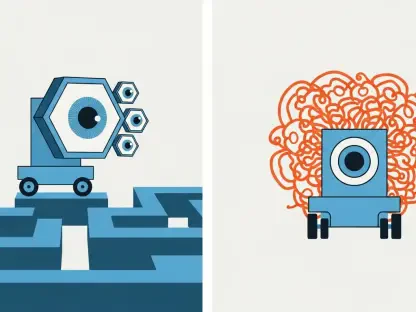In a rapidly evolving tech landscape, Laurent Giraid stands out for his profound expertise in Artificial Intelligence, with a keen focus on machine learning, natural language processing, and AI ethics. With notable advancements like Salesforce’s deployment of AI agents, there are valuable insights and lessons to unravel. Laurent sheds light on these transformative milestones and the implications for enterprise AI deployment.
Can you provide an overview of Salesforce’s recent milestone with AI deployment on its help portal?
Salesforce has achieved a monumental step by surpassing one million autonomous agent conversations on their help portal. This milestone reflects not just the scale of their AI deployment but also the efficiency and capability of their AI agents. Impressively, these agents now autonomously resolve 84% of customer queries and have led to a 5% reduction in overall support case volume, allowing the company to redeploy 500 human support engineers to roles that add more value.
What lessons did Salesforce learn from being “customer zero” for their AI technology?
Being “customer zero” allowed Salesforce to gain invaluable insights into the integration of AI with real-world user interactions. This experience highlighted the delicate balance needed between maintaining technological capability and ensuring human empathy. It brought to light challenges and prompted strategic changes, such as incorporating empathy into interactions to better meet customer expectations.
What was the initial approach and strategy for deploying AI agents at Salesforce?
The initial rollout was methodical and cautious. Salesforce started small by deploying to a select cohort of customers on their Help Portal, limiting it to logged-in users and handling a small percentage of traffic to fine-tune the system. This allowed them to closely monitor and learn from each interaction, ensuring they could identify and rectify any issues without impacting their entire customer base.
How did Salesforce scale the use of AI from 126 to 45,000 conversations weekly?
Salesforce adopted a phased deployment strategy. By starting with just 126 weekly conversations, they were able to gradually refine their processes. As confidence grew and more issues were ironed out, they incrementally increased the scope, ultimately scaling to handle 45,000 conversations weekly while maintaining quality and accuracy.
Can you explain the phased deployment strategy and its advantages over the “move fast and break things” ethos?
The phased strategy emphasized the importance of caution and control over speed. By slowly rolling out AI capabilities, Salesforce could identify and mitigate issues early on, avoiding potential large-scale disruptions. This contrasts sharply with the more reckless “move fast and break things” approach, focusing instead on stable and sustainable growth.
How did Salesforce leverage its Data Cloud to enable AI agents to handle a broad range of customer queries?
The Data Cloud plays a crucial role by integrating and synthesizing data from 740,000 pieces of content across languages and product lines. This setup allows the AI to effectively respond to an extensive variety of queries by accessing a vast pool of information, which wouldn’t be feasible with traditional chatbot architectures that rely on limited, pre-programmed scripts.
What unexpected challenges did Salesforce face regarding AI agent responses, and how did they address them?
One major challenge was the initial cold and factual nature of the AI responses, which customers found off-putting. Salesforce addressed this by incorporating soft skills and empathy into AI interactions. By teaching the AI to recognize and respond to emotional cues, they significantly improved customer satisfaction and engagement.
How did integrating empathy into AI conversations improve customer satisfaction at Salesforce?
Integrating empathy transformed AI interactions from robotic to relatable. By apologizing and acknowledging customer frustrations, AI agents created experiences that felt more supportive and human. This shift not only improved customer satisfaction but also increased trust and acceptance of AI capabilities.
What prompted Salesforce to increase its AI to human handoff rate from 1% to 5%?
The initial low handoff rate led to frustration when customers needed human intervention that the AI couldn’t provide. By raising the rate to 5%, Salesforce allowed smoother transitions to human agents, which enhanced the overall customer experience and satisfaction by ensuring needs were met adequately and promptly.
How does the balance between AI agents and human support personnel impact overall customer experience?
A balanced approach leverages the strengths of both AI and human agents. AI handles routine queries efficiently, freeing human agents to tackle more complex issues. This symbiotic relationship improves overall service quality, reduces wait times, and enhances customer satisfaction by delivering personalized and empathetic responses when needed.
What insights did Salesforce gain about content management when deploying AI agents?
Salesforce discovered the importance of “content hygiene.” They found that having too much outdated or redundant content confused the AI, so they focused on refining and updating their content to ensure the AI had access to accurate and relevant information, improving response accuracy and reliability.
Can you elaborate on the term “content collisions” and its significance in AI deployment?
“Content collisions” occur when multiple pieces of content provide similar but potentially conflicting information, causing confusion for AI systems trying to determine which is correct. This can lead to miscommunication with users, so managing and streamlining content is crucial to maintain accuracy and consistency in AI responses.
How did being overly restrictive with AI guardrails backfire during Salesforce’s deployment?
Initially, Salesforce restricted their AI from discussing competitors, which inadvertently blocked legitimate inquiries about integrations, such as with Microsoft Teams. This rigidity demonstrated the necessity for a more flexible approach, enabling the AI to operate with greater autonomy and effectiveness by understanding broader contexts.
What changes did Salesforce make to its guardrails, and what were the outcomes?
Salesforce shifted from rigid guidelines to a more flexible directive, instructing AI to act in Salesforce’s best interest. This change empowered the AI to handle inquiries more dynamically and appropriately, leading to better customer engagement and more accurate handling of complex or sensitive inquiries.
How does Salesforce plan to implement and evolve voice interfaces in its AI agents?
Salesforce aims to make voice interfaces a key component of their AI agents. They are developing native apps with voice capabilities, viewing voice as the ultimate user interface for AI. This evolution is anticipated to enhance accessibility and usability, making AI interactions more intuitive and efficient in real-time.
What are the specific challenges and opportunities associated with voice interfaces in AI?
Voice interfaces require speed and accuracy, presenting challenges in processing and responding to queries quickly. However, they also offer opportunities for more natural and seamless interactions, reducing user effort and enabling more direct communication, leading to enhanced user experiences.
Can you discuss Salesforce’s approach to supporting multilingual capabilities for AI agents?
For multilingual support, Salesforce translates customer queries into English, retrieves the necessary information, and then translates the response back to the original language. This innovative approach allows them to quickly expand language support, maintaining high resolution rates and responsiveness across different languages.
What were the key lessons Salesforce learned from the deployment of its AI agents?
Key lessons include starting with a focused, controlled rollout, ensuring content accuracy, and balancing AI autonomy with human intervention. They discovered the value of empathy and flexibility in AI interactions, realizing the importance of rethinking traditional metrics to reflect the evolving nature of AI deployment.
How does Salesforce redefine success metrics for AI agents compared to traditional support metrics?
Success metrics for AI agents now include not only accuracy and resolution rates but also the quality of interaction, empathy, and appropriate transitions to human agents. These new metrics better capture the holistic nature of customer experience and the effectiveness of AI in enhancing support services.
What does Salesforce believe is the next step after AI agents outperform human agents?
After surpassing human performance in some metrics, Salesforce is focused on further enhancing customer experience and refining service quality. They recognize the opportunity to innovate beyond capabilities, leveraging AI to transform and redefine the standards for exceptional service in an AI-driven world.
How are Salesforce’s AI agents transforming the concept of good service in an AI-first world?
Salesforce’s AI transformation combines efficiency with empathy, moving beyond mere automation to deliver experiences that feel genuinely supportive and human. By doing so, they are setting new standards for customer service, where machines enhance human capabilities rather than replace them.
What are the broader implications of Salesforce’s AI journey for enterprise AI deployment?
Salesforce’s journey illustrates the importance of strategic, empathetic AI deployment. It underscores the necessity for continuous learning and adaptation, highlighting how enterprises can leverage AI to not only improve efficiency but also enrich customer experiences and redefine operational paradigms.
How does Salesforce ensure a synergy between human employees and AI agents?
Salesforce recognizes that AI and human agents each bring unique strengths to support services. They ensure synergy by training both in soft skills and allowing AI to handle routine tasks, freeing humans to focus on complex issues, thereby creating a balanced and enhanced customer service experience.
Why does Salesforce emphasize teaching AI agents soft skills, and what is the “art of service”?
Soft skills are crucial for AI to interact effectively and empathetically with customers. Salesforce’s “art of service” program teaches AI to recognize emotional nuances, apologize when needed, and offer supportive responses, all of which contribute to improved customer satisfaction and loyalty.
What future trends and shifts does Salesforce foresee in the realm of generative AI and enterprise solutions?
Salesforce anticipates a continued trend towards more intuitive, human-like AI interactions and the expansion of AI capabilities across languages and platforms. They foresee AI not only transforming service industries but also fundamentally altering how enterprises operate, innovate, and engage with customers, driving a new era of technological integration and progression.









